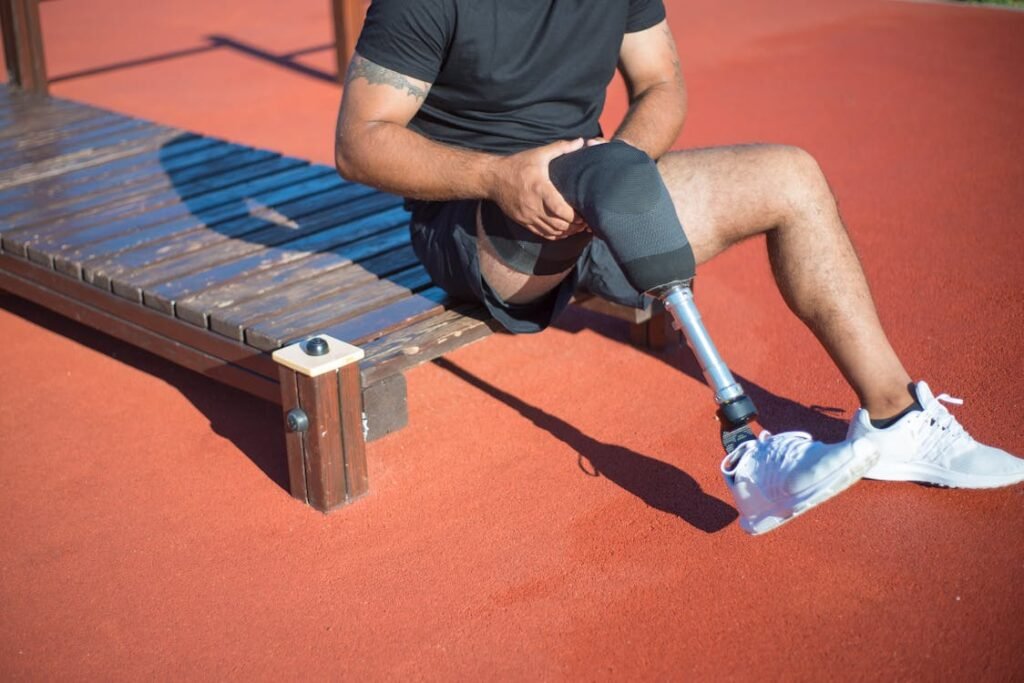Losing a limb is life-changing, and along with the physical and emotional adjustments, pain is a significant challenge many amputees face. Pain after amputation is not just about the healing process; it can persist for months or even years if not managed properly. Whether it is phantom limb pain, nerve pain, or discomfort from using a prosthetic, pain can make recovery difficult.
However, pain does not have to control your life. With the right techniques and support, it is possible to manage pain effectively and regain comfort. Rehabilitation is not just about learning to walk or use a prosthetic—it is also about addressing pain so that daily activities become easier and more enjoyable.

Understanding Pain After Amputation
Pain after amputation is complex and can affect both the body and the mind. Many amputees assume that once the surgical site heals, the pain will fade.
However, different types of pain can appear at different stages of recovery. Some experience sharp, sudden sensations, while others feel a constant dull ache. Understanding the nature of this pain is the first step toward managing it effectively.
Phantom Limb Pain and Sensations
One of the most common types of post-amputation pain is phantom limb pain. This occurs when the brain still perceives the missing limb as if it were there.
Amputees may feel itching, tingling, pressure, or even severe pain in the part of the limb that no longer exists. This happens because the brain and nervous system continue sending signals to the absent limb, creating the illusion of sensation.
Phantom limb pain can be frustrating and, at times, overwhelming. Some people experience mild discomfort, while others feel intense, sharp pain that disrupts daily life.
The unpredictability of these sensations can make them difficult to manage, but with the right techniques, they can be controlled and reduced over time.
Residual Limb Pain
Pain in the remaining part of the limb, also known as residual limb pain, is another common issue. This pain can be caused by nerve damage, poor blood circulation, muscle stiffness, or sensitivity in the scar tissue.
Some amputees feel a deep aching sensation, while others experience shooting pain when the residual limb is touched or when pressure is applied.
In some cases, the prosthetic socket may cause additional discomfort if it does not fit correctly. Pressure sores, skin irritation, and excessive friction can make it painful to wear a prosthetic for long periods.
Ensuring a well-fitted socket and addressing any skin issues early can help reduce this type of pain.
Nerve Pain and Neuroma Formation
During amputation, nerves are cut and sealed, but they do not always heal smoothly. Sometimes, the nerve endings form small bundles of scar tissue called neuromas.
These can be extremely sensitive and cause shooting or burning pain when touched or compressed. Neuromas can make wearing a prosthetic difficult and may require specific treatments to relieve discomfort.
Nerve pain can also result from overactive nerve signals. When nerves become hypersensitive, they may send pain signals even without an obvious trigger.
This type of pain can be challenging to manage, but various rehabilitation techniques can help calm the nervous system and reduce discomfort.
The Emotional Connection to Pain
Pain after amputation is not just physical; it is also deeply connected to emotions. Stress, anxiety, and depression can amplify pain, making it feel more intense than it actually is. When the mind is in distress, the body reacts by increasing muscle tension and sensitivity to pain signals.
Many amputees feel frustrated, angry, or hopeless when pain lingers longer than expected. Some may withdraw from social activities or struggle with sleep, which further worsens their discomfort.
Learning to manage emotional well-being is just as important as treating physical pain, as both are closely linked in the recovery process.
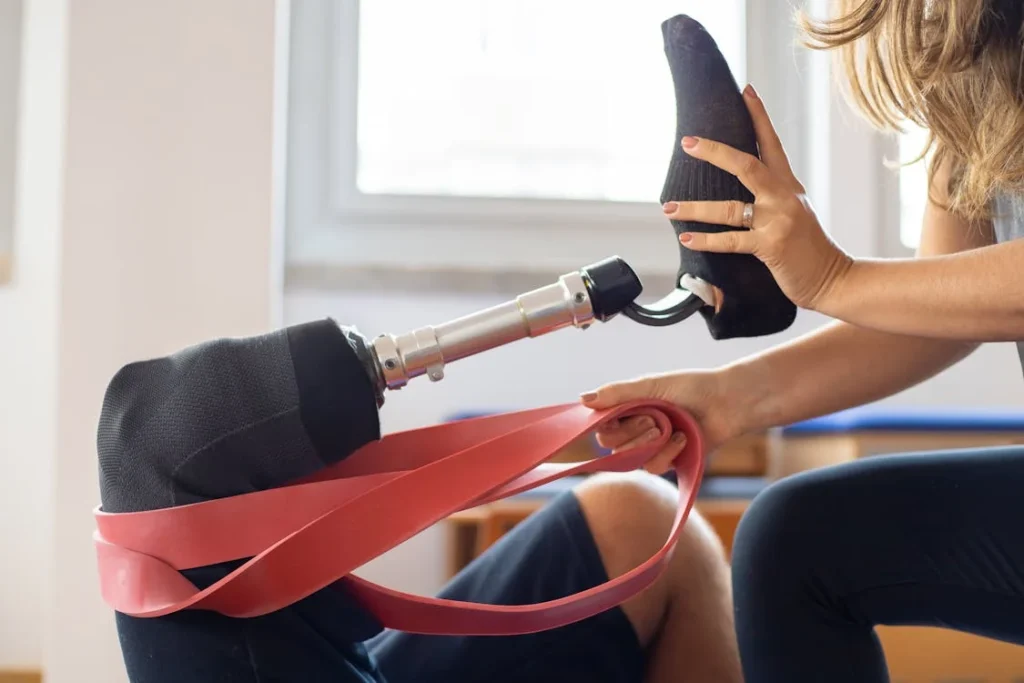
Effective Pain Management Techniques in Amputation Rehabilitation
Pain management after amputation requires a combination of physical, medical, and psychological strategies. Since pain affects every individual differently, the best approach is one that is tailored to personal needs.
By using the right techniques, amputees can reduce pain, improve mobility, and enhance their overall quality of life.
Medical Treatments for Pain Relief
Doctors may recommend different medical treatments to help control post-amputation pain.
Medications such as pain relievers, anti-inflammatory drugs, or nerve pain medications can provide relief. In cases where nerve pain is severe, certain medications can help calm overactive nerve signals and prevent sharp, burning sensations.
For phantom limb pain, mirror therapy is often effective. This technique involves using a mirror to reflect the intact limb, creating an illusion that the missing limb is still present.
By performing exercises with the mirrored limb, the brain is retrained to stop sending pain signals to the missing limb. Many amputees have found significant relief from phantom pain using this method.
Another treatment option is desensitization therapy, which helps reduce sensitivity in the residual limb. This involves gently massaging the limb, tapping it, or applying different textures to help the nerves adapt.
Over time, these techniques can decrease hypersensitivity and make wearing a prosthetic more comfortable.
Physical Therapy and Muscle Conditioning
Rehabilitation exercises play a crucial role in pain management. After an amputation, the surrounding muscles need to be strengthened to support movement and balance.
Weak muscles can lead to poor posture and increased strain on the residual limb, which may cause additional pain.
Stretching exercises help prevent stiffness and improve circulation, reducing discomfort in the residual limb. Strength training focuses on the core, back, and remaining limb to improve stability and make prosthetic use easier.
Learning how to distribute weight evenly while walking or moving can also prevent unnecessary strain on the body.
Massage therapy can provide additional relief by improving blood flow and reducing muscle tension. Many amputees find that gentle massage around the residual limb helps relieve tightness and improves relaxation.
Managing Pain While Using a Prosthetic
A well-fitted prosthetic can significantly reduce pain, but it must be customized to match the shape and needs of the residual limb. If a prosthetic socket is too tight or causes pressure points, it can lead to soreness, irritation, and even skin breakdown.
Regular follow-ups with a prosthetist ensure that any discomfort is addressed early. Adjustments can be made to improve fit and reduce friction. Some amputees use gel liners or cushioning socks to create a more comfortable interface between the limb and the socket.
For those experiencing pain from prolonged prosthetic use, pacing activities and taking breaks can help prevent overuse injuries. Alternating between prosthetic and non-prosthetic activities throughout the day allows the residual limb to rest and recover.
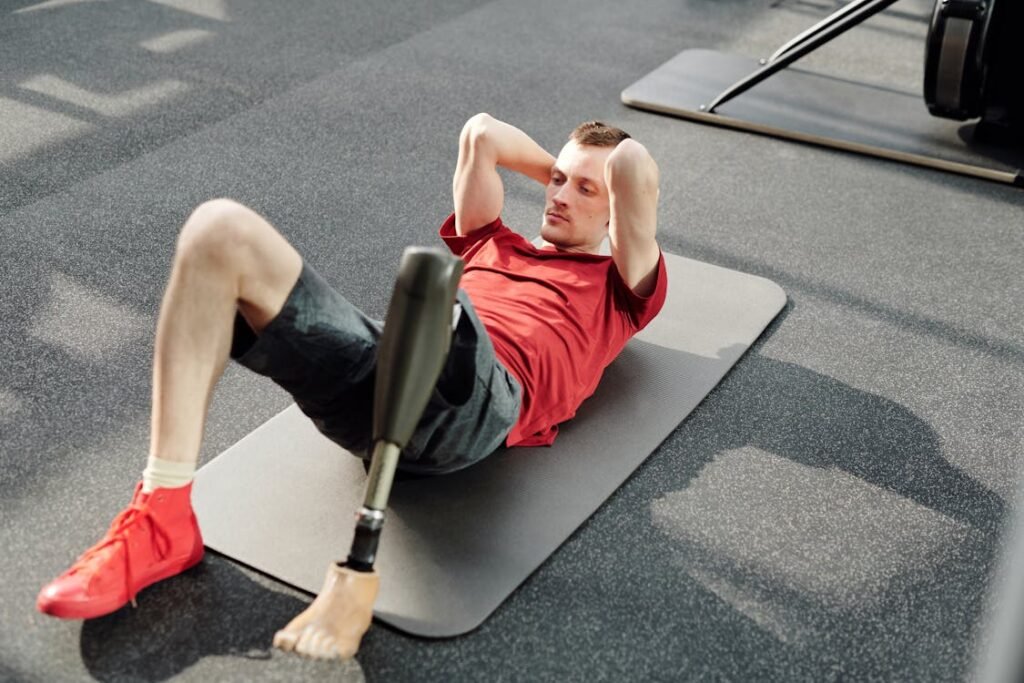
Psychological Strategies for Pain Management
Pain is not just a physical experience; it is deeply influenced by emotions, stress levels, and mental well-being. For many amputees, anxiety and frustration make pain feel worse, creating a cycle that is difficult to break.
Learning to manage thoughts and emotions plays a crucial role in reducing pain and improving overall comfort.
The Power of Relaxation Techniques
When the body is tense, pain signals become more intense. Relaxation techniques such as deep breathing, meditation, and guided imagery can help calm the nervous system and reduce pain perception.
Simple breathing exercises, like inhaling deeply through the nose and exhaling slowly through the mouth, can ease muscle tension and promote relaxation.
Mindfulness meditation is another effective tool. By focusing on the present moment rather than worrying about pain, amputees can shift their attention away from discomfort.
Studies have shown that mindfulness reduces stress, lowers pain intensity, and improves emotional resilience. Practicing for just a few minutes a day can make a noticeable difference.
Visualization techniques also help in pain management. By imagining warmth, healing, or even picturing the pain fading away, the brain can be trained to respond differently to discomfort.
Some amputees find that imagining themselves moving pain-free or engaging in a favorite activity reduces their pain levels.
Cognitive Behavioral Therapy (CBT) for Pain Relief
Thoughts and emotions have a direct impact on pain levels. If an amputee constantly worries about their pain or believes it will never improve, the brain reinforces these negative signals.
Cognitive Behavioral Therapy (CBT) is a proven psychological approach that helps change negative thought patterns and replace them with more constructive ones.
CBT involves recognizing unhelpful thoughts—such as “I will always be in pain” or “I can’t do anything because of my amputation”—and challenging them with more balanced perspectives.
Reframing these thoughts to “I am learning to manage my pain” or “I am adapting and getting stronger every day” creates a positive shift in mindset.
Therapists trained in CBT can guide amputees through specific exercises that reduce pain-related anxiety and promote a sense of control. Over time, this method helps break the cycle of pain and emotional distress, leading to improved physical and mental well-being.
The Importance of Social Support
Pain often feels worse when faced alone. Having a strong support system makes a significant difference in how pain is experienced and managed.
Talking to friends, family, or support groups allows amputees to share their struggles, gain encouragement, and learn new coping strategies.
Connecting with others who have gone through similar experiences can be incredibly empowering. Amputee communities, both online and in-person, provide reassurance that pain is a shared challenge—and one that can be overcome.
Exchanging stories, advice, and encouragement helps reduce feelings of isolation and provides motivation for continued recovery.
At Robobionics, we have seen firsthand how a combination of physical, medical, and psychological strategies can help amputees regain control over their pain.
Pain management is not about eliminating discomfort overnight—it is about finding effective ways to reduce pain, build resilience, and move forward with confidence.
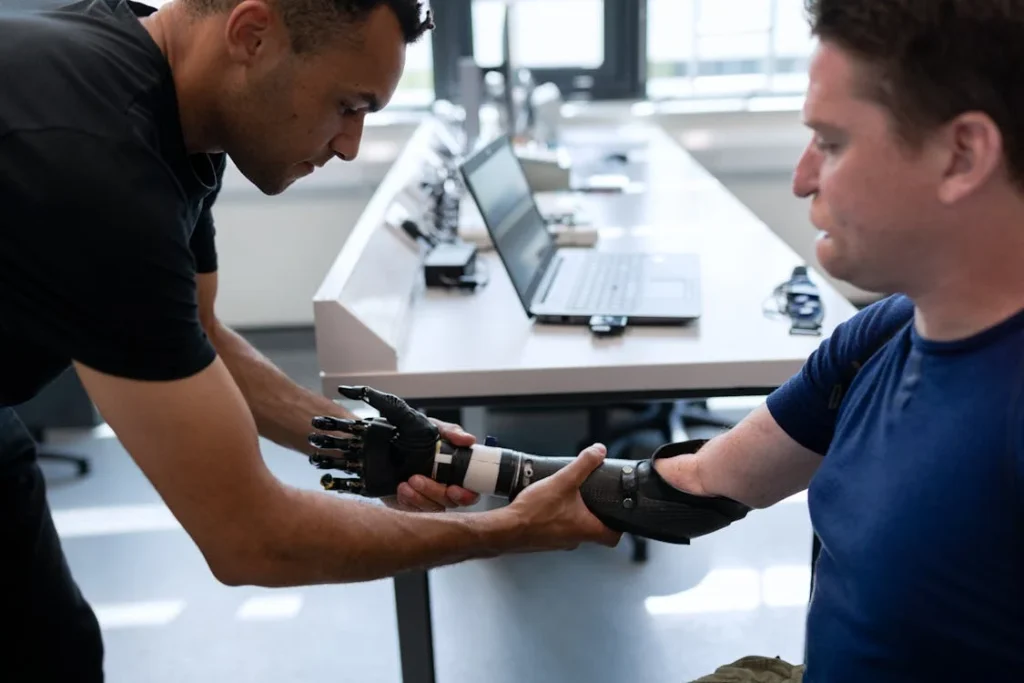
Lifestyle Adjustments to Reduce Pain and Improve Comfort
Managing pain after amputation is not just about medical treatments and therapy sessions. Everyday habits, routines, and lifestyle choices play a significant role in reducing discomfort and improving overall well-being.
Small adjustments in daily life can make a big difference in how the body responds to pain and how easily an amputee adapts to their new reality.
The Role of Nutrition in Pain Management
What a person eats has a direct impact on inflammation and pain levels. Certain foods can either increase or decrease inflammation in the body, which affects how pain is experienced.
A diet rich in anti-inflammatory foods—such as leafy greens, berries, nuts, and omega-3-rich fish—can help reduce nerve pain and improve healing. Drinking plenty of water also keeps the muscles and joints flexible, preventing stiffness and discomfort.
Processed foods, excess sugar, and unhealthy fats can worsen inflammation, making pain management more difficult. Many amputees find that cutting back on these foods leads to noticeable improvements in their overall comfort.
Working with a nutritionist or simply making healthier food choices can support both physical and emotional recovery.
The Importance of Quality Sleep
Pain often feels worse when the body is tired. Poor sleep increases sensitivity to pain, making discomfort more difficult to manage. Amputees who struggle with sleep often find themselves caught in a cycle where pain keeps them awake, and lack of sleep makes the pain worse.
Creating a bedtime routine that promotes relaxation can help improve sleep quality. Avoiding caffeine or heavy meals before bed, maintaining a comfortable sleeping position, and using pillows to support the residual limb can make falling asleep easier.
Some amputees find that playing soft music or using a white noise machine helps calm their mind and body.
If phantom limb pain disrupts sleep, gentle stretching or massaging the residual limb before bed may help reduce discomfort. Meditation or deep breathing exercises can also quiet the mind and prepare the body for rest.
Staying Active Without Overexertion
Exercise plays a crucial role in rehabilitation, but it is important to find the right balance. Too much activity can cause fatigue and soreness, while too little movement can lead to stiffness and increased pain. The goal is to stay active without putting unnecessary strain on the body.
Low-impact activities like swimming, cycling, and yoga help keep the body flexible and strong without causing excessive stress on the residual limb.
Many amputees find that adaptive sports and customized fitness programs designed for their needs help maintain mobility while preventing pain.
Daily stretching and simple movements, even if done at home, can prevent stiffness and improve circulation. Regular physical activity releases endorphins, the body’s natural painkillers, which help reduce pain and improve mood.
Managing Stress to Reduce Pain Sensitivity
Stress is one of the biggest contributors to pain. When the body is under stress, it produces chemicals that increase pain perception. Learning to manage stress effectively can significantly improve pain levels and overall quality of life.
Simple stress-reduction techniques, such as spending time in nature, engaging in hobbies, and practicing mindfulness, can help shift focus away from pain.
Finding enjoyable and relaxing activities—whether it is painting, listening to music, or spending time with loved ones—can provide a mental escape from discomfort.
Regular social interaction also helps reduce stress. Talking to friends, joining an amputee support group, or participating in community events can create a sense of connection and support. When an amputee feels emotionally supported, their ability to manage pain improves.
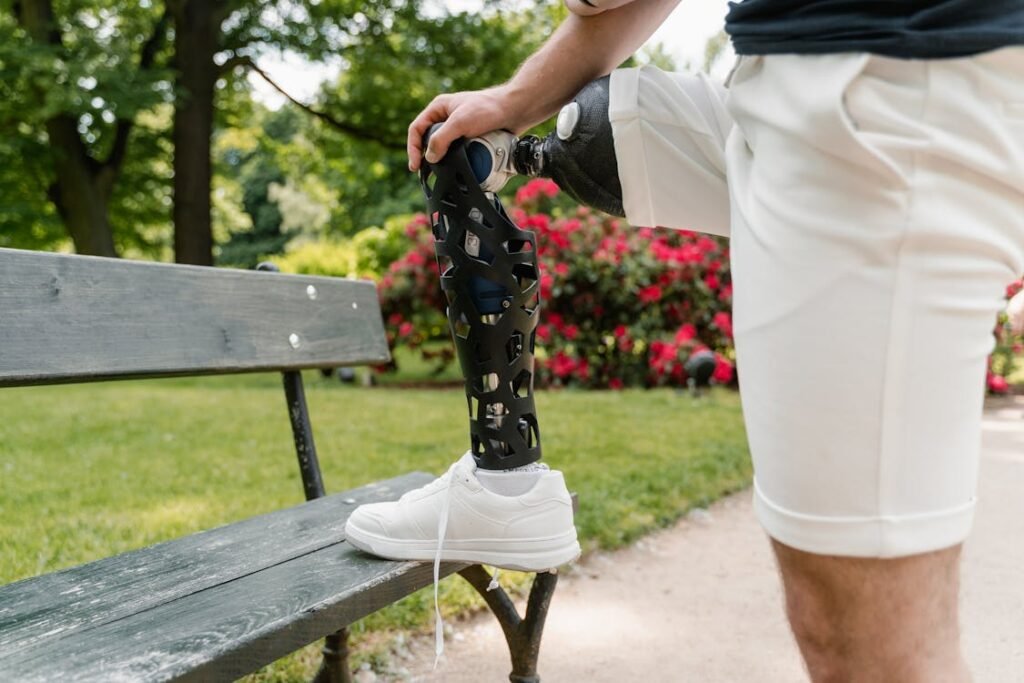
Long-Term Pain Management and Adapting to Life After Amputation
Pain management is not just about finding immediate relief—it is about developing long-term strategies that allow amputees to live comfortably and confidently.
As the body adapts to life after amputation, pain can change over time. Some discomfort may lessen, while new challenges may arise, especially with prolonged prosthetic use or changes in activity levels.
Understanding how to manage pain in the long run ensures a better quality of life.
Adapting to Changes in the Residual Limb
Over time, the residual limb undergoes changes that can affect pain levels. As the swelling from surgery subsides and muscles adapt, the limb may shrink or change shape.
This can lead to discomfort, especially if the prosthetic socket no longer fits properly. Regular adjustments with a prosthetist help ensure that the prosthetic remains comfortable and does not create pressure points or irritation.
In some cases, amputees may experience new types of pain as they become more active. Using different muscle groups, standing for longer periods, or engaging in new physical activities can lead to soreness.
Recognizing the difference between normal muscle fatigue and pain that signals a problem is important. Pain that persists or worsens should always be discussed with a doctor or therapist.
Continuing Rehabilitation for Pain Prevention
Many amputees assume that once they learn to use a prosthetic, rehabilitation is complete. However, ongoing physical therapy and regular check-ins with rehabilitation specialists can prevent future pain problems.
As the body compensates for the lost limb, there is often extra strain on certain muscles, joints, and the spine. Without proper guidance, this imbalance can lead to chronic pain or posture issues.
Exercises that focus on core strength, balance, and flexibility help maintain comfort and prevent unnecessary strain on the body. Regular stretching and low-impact activities like swimming or yoga can keep muscles relaxed and reduce long-term stiffness.
For upper-limb amputees, continued occupational therapy ensures that repetitive movements, such as gripping or lifting objects, do not lead to strain-related pain.
Learning proper techniques for daily tasks can prevent unnecessary pressure on the residual limb and reduce discomfort.
The Role of Technology in Long-Term Pain Management
Advancements in prosthetic technology have made pain management easier for many amputees. Modern prosthetics, like those offered by Robobionics, are designed with improved weight distribution, shock absorption, and flexible materials to minimize strain on the body.
Some prosthetics include microprocessor-controlled joints that adjust to movement in real time, reducing the effort required for walking or gripping. Newer socket designs focus on reducing friction and pressure, making long-term use more comfortable.
For those experiencing persistent nerve pain, medical technology offers additional solutions such as targeted nerve stimulation or implanted devices that help regulate pain signals.
Research in this area continues to advance, providing more options for amputees seeking lasting relief.
Embracing a Pain-Free Future
Pain after amputation can feel overwhelming, but it does not have to define daily life. With the right combination of medical care, rehabilitation, lifestyle adjustments, and emotional support, pain can be effectively managed.
The key is to stay proactive—seeking treatment when needed, staying physically active, and maintaining a positive mindset toward recovery.
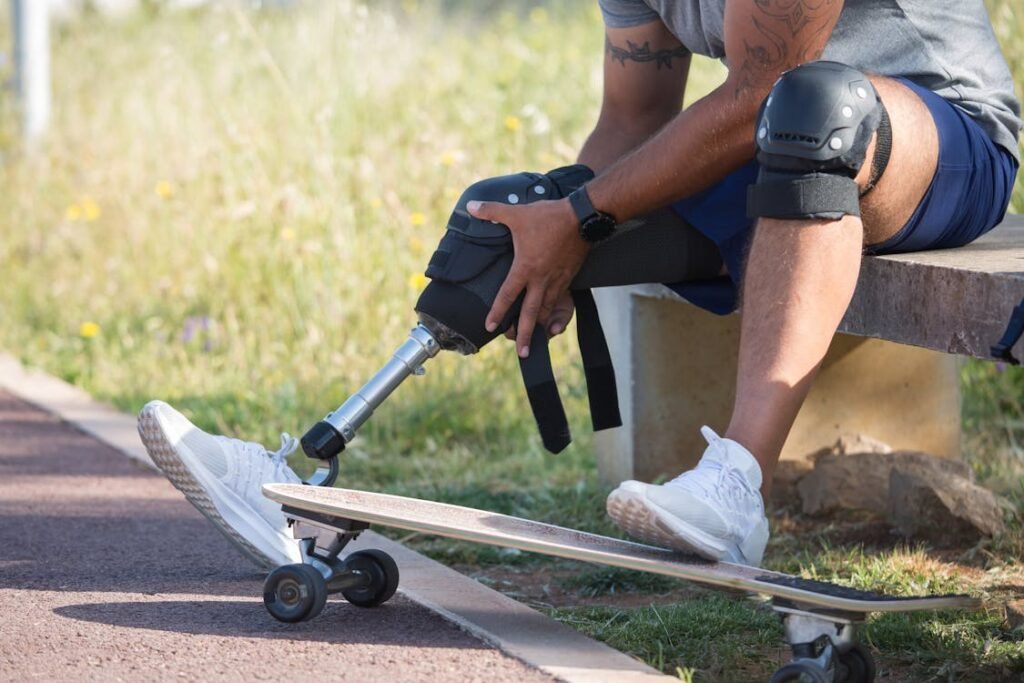
The Connection Between Mental Health and Pain Perception
Pain is not just a physical experience—it is deeply tied to emotions, thoughts, and overall mental well-being. Amputees who struggle with anxiety, depression, or stress often report higher levels of pain.
This is because the brain processes pain and emotions in the same areas, meaning that negative emotions can amplify discomfort.
How Emotional Distress Affects Pain
When someone is stressed or anxious, the body releases chemicals that increase inflammation and muscle tension. This makes pain feel sharper and more persistent.
Many amputees who experience social anxiety or feelings of isolation find that their physical discomfort worsens during emotionally difficult periods.
Depression can also intensify pain by reducing motivation to move, exercise, or engage in therapy. A lack of movement leads to stiffness, poor circulation, and increased sensitivity in the residual limb.
Some amputees get caught in a cycle where pain leads to sadness, and sadness makes the pain worse. Recognizing this connection is the first step in breaking the cycle.
Improving Mental Health to Reduce Pain
Mental health care should be part of every amputee’s pain management plan. Therapy, counseling, and peer support groups can help amputees process the emotional side of limb loss.
Talking to someone who understands their struggles can ease feelings of loneliness and reduce stress-related pain.
Meditation and relaxation techniques also help regulate pain perception. Studies show that mindfulness can rewire the brain to process pain differently, making it feel less intense.
Regular practice, even for just a few minutes a day, can significantly improve an amputee’s ability to manage discomfort.
Journaling is another powerful tool. Writing about pain, fears, and emotions can provide clarity and relief. It helps amputees track patterns in their pain levels, identify triggers, and develop coping strategies that work best for them.
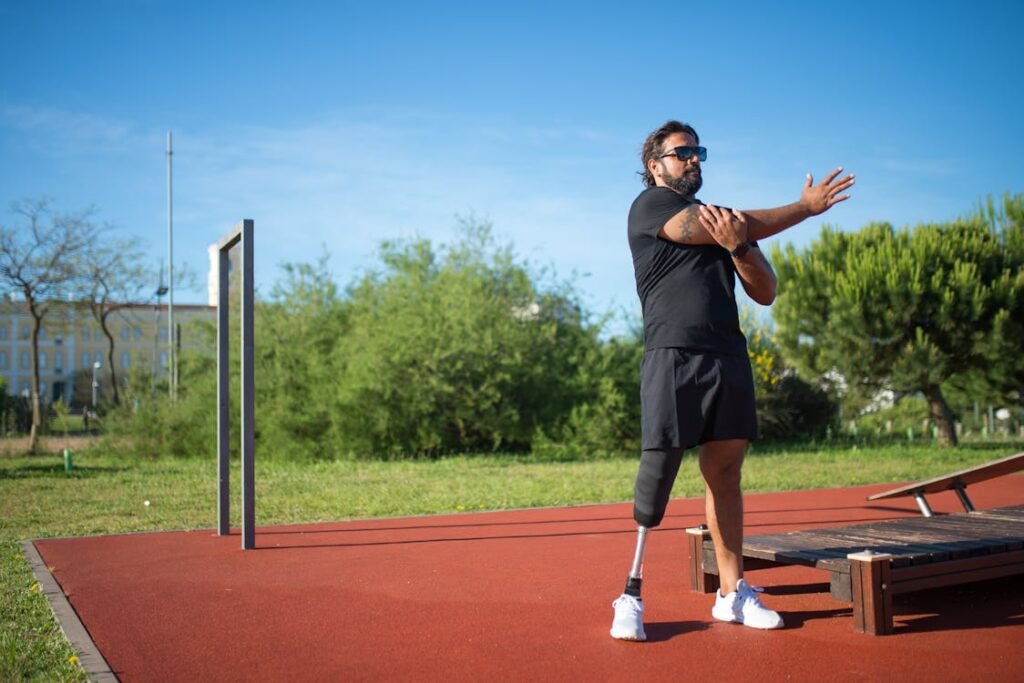
Alternative and Holistic Pain Management Approaches
For those looking for non-medical ways to control pain, holistic treatments can be highly effective. Many amputees find relief through natural therapies that focus on relaxation, movement, and energy balance.
Acupuncture and Nerve Stimulation
Acupuncture, an ancient Chinese practice, has been used for centuries to treat pain. By inserting thin needles into specific points on the body, it helps release natural painkillers and improve circulation.
Some amputees have reported reduced phantom limb pain and overall discomfort after consistent acupuncture sessions.
Electrical nerve stimulation is another technique that can help. Small electrodes placed on the skin send gentle electric pulses to disrupt pain signals.
This method, known as TENS (Transcutaneous Electrical Nerve Stimulation), is commonly used in rehabilitation centers and can be done at home with guidance from a therapist.
Heat and Cold Therapy
Simple treatments like heat and cold therapy can provide significant relief. Applying a warm compress or heating pad to the residual limb relaxes muscles and improves blood flow, reducing stiffness and aching pain.
Cold therapy, using ice packs or cooling gels, can numb nerve pain and reduce swelling.
Many amputees find that alternating between heat and cold provides the best results. A warm bath or shower before bed can also help relax muscles and reduce nighttime discomfort.
Essential Oils and Aromatherapy
Some amputees use aromatherapy as a natural way to manage pain. Certain essential oils, like lavender, peppermint, and eucalyptus, have calming and pain-relieving properties.
Rubbing diluted essential oils on the residual limb or using a diffuser to inhale the scents can promote relaxation and ease discomfort.
While holistic treatments may not replace medical interventions, they can be a valuable part of an amputee’s pain management routine. Experimenting with different methods can help each individual find what works best for them.
Adapting to Weather-Related Pain
Many amputees notice that their pain worsens during certain weather conditions. Cold temperatures can make the residual limb feel stiff and achy, while sudden weather changes can trigger phantom limb pain.
Understanding how weather affects the body and taking preventive measures can help minimize discomfort.
Managing Cold Weather Pain
During winter or in air-conditioned environments, blood vessels constrict, reducing circulation to the residual limb. This can cause stiffness and increased sensitivity.
Wearing a thermal liner under a prosthetic, keeping the residual limb warm with thick socks or leg warmers, and staying active to maintain blood flow can help prevent cold-related pain.
Some amputees find that using warming creams or heating pads before putting on their prosthetic improves comfort. Drinking warm beverages and dressing in layers also help keep the body temperature stable.
Dealing with Humidity and Pressure Changes
Changes in barometric pressure, especially before storms, can increase nerve pain and phantom sensations. While the exact reason is not fully understood, it is believed that pressure changes affect nerve signals and fluid levels in the body.
Staying hydrated and doing gentle stretching exercises can help the body adjust to these shifts. Some amputees find that compression garments provide relief by stabilizing circulation.

The Role of Long-Term Support and Education
Pain management is an ongoing journey, and having access to continuous support makes a big difference. Many amputees benefit from staying connected with healthcare professionals, prosthetists, and peer communities to learn new strategies and receive encouragement.
Ongoing Prosthetic Adjustments
A prosthetic that fits well today may need adjustments in the future. Changes in weight, muscle mass, or activity level can affect the way a prosthetic feels. Regular follow-ups with a prosthetist ensure that discomfort is addressed before it turns into chronic pain.
Some amputees switch to more advanced prosthetics as technology evolves. Upgrading to a lighter, more flexible design can improve comfort and reduce strain on the body.
Staying informed about the latest developments in prosthetic technology helps amputees make the best choices for their needs.
Staying Educated on Pain Management Techniques
Medical research continues to discover new methods for pain relief. Amputees who stay informed about the latest treatments—whether through support groups, online resources, or discussions with healthcare providers—have more options for managing pain effectively.
Workshops and rehabilitation programs offer hands-on guidance for improving mobility and reducing discomfort. Many organizations provide training on gait correction, muscle strengthening, and adaptive techniques that make daily activities easier.
Conclusion
Pain after amputation is a challenge, but it does not have to dictate how life is lived. With the right combination of medical treatments, physical rehabilitation, psychological strategies, and lifestyle adjustments, pain can be managed effectively. The key is to stay proactive—understanding the body’s signals, seeking help when needed, and being open to different techniques that promote comfort and well-being.
At Robobionics, we are committed to helping amputees move forward with comfort and confidence. Our prosthetic solutions are designed with innovation and adaptability in mind, ensuring that every user gets the best possible fit for their needs. We also believe in the power of rehabilitation, education, and community support to create a holistic recovery experience.



